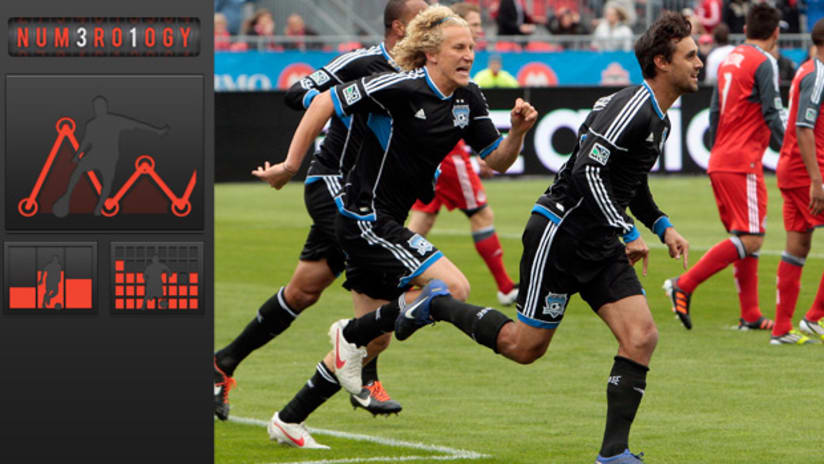Welcome to Part 3 of our Numerology Q&A with four MLS performance analysts. Today we'll be getting their thoughts on possession, formations and strikers.
Click here for Part 2.
Devin Pleuler: What do you think about possession statistics? What statistical measurements do you believe are useful?
Timothy Crawford – New England Revolution: It’s definitely something worth looking at. It’s hard to say exactly what possession necessarily does at this point. Barcelona out-possesses everyone, but they certainly dropped some points and big matches. There have been studies that have shown teams that win often lose the possession battle, but as my statistics classes taught me, correlation does not necessarily imply causation. No one is saying the way to win more matches is to never have the ball. It’s trying to find what part of possession is important, and then applying that to tactics.
David Lee – New York Red Bulls: Possession and passing statistics absolutely can be useful in describing or understanding elements of a match, but equally I don't feel that currently they're well understood or used. As with anything in soccer statistics, the most important thing to consider is the context and limitations of the statistic you're looking at – not every pass is of equal value to a team and so a very high passing completion percentage can very well be a good thing. But it doesn't always mean a successful performance.
Unbreakable Records - Dodd's 191 saves
Sean Rubio – San Jose Earthquakes: At the risk of stating the obvious, possession stats are valuable insofar as telling you what team/player had the ball the most. To say that this will affect the end result on all matches (or even most matches) would be a gross overstatement. I think plenty of statistics are useful in a vacuum, but we’ve barely scratched the surface in terms of using advanced metrics to determine the value of an event/player.
Rui Xu – Sporting Kansas City: In general, I think they’re useless because they don’t contain any context. There is little-to-no correlation with points (if anything, there’s a slightly negative correlation in the MLS), and it doesn’t really tell you anything on a performance analysis level. Once you start adding context is when you’ll be able to draw some narratives. What is the possession percentage of the road team after they go up 1-0? What was it before? What is the possession percent of the home team when up 2-0 after the 80th minute? You still have to be very, very cautious though.
On a game-by-game basis, the sample sizes are too small to draw firm conclusions, but if you take in possession stats from every game in MLS history, you’ll start to see what teams tend to do, and from there, it’s pretty basic game theory on how you should react to those situations if you know they’re going to occur.
Pleuler: What is more important: what position a player plays or how a player plays the position?
Crawford: Formation, shape, position and role have a major effect on statistics. It’s obviously incorrect to compare a holding midfielder’s strike rate with a target forward. When trying to find new talent, the statistics may show someone to be valuable number-wise, but it may be somewhat a product of the system they are playing in and they may not be a good fit for what your team is trying to do. If a guy is a wing forward in a three-forward system and you want to evaluate him as one of two forwards in a conventional 4-4-2, what numbers do you look at to judge him?
Basically, I think it shows how you have to combine looking at the numbers with soccer sense to judge if a player is a good fit. I mean, this is what makes the job interesting. If it was as simple as wanting your forwards to score goals and you just looked at who has a track record of scoring goals, everyone would assume signing the leading goal scorer from whatever team in whatever league would mean instant success. However, that’s not typically the case, and that’s where analytics adds another dimension in determining which forward is the best fit for your team strategy, formation, and personnel.
Pleuler: What do you believe the difference is between "formation" and "shape"? Are rigid definitions helpful or hurtful?
Lee: This is a real annoyance of mine – formations are attempting to condense 90 minutes of constant interaction and movement into a set of four simple numbers to provide a complete description of a team (and even how attacking/defensive they are just based off these numbers). I really think that most "formations" are relatively useless as there is no accepted definition of what the formation is intended to show – by this, I mean does formation relate to the organization in attack or defense? They are usually very different for every team.
So many teams, particularly in MLS, are called as 4-3-3 teams yet all this really means is that they defend in a variation of 4-5-1 and when in possession, two wide players join the attack quickly. Admittedly, it's a subtle difference, but it certainly does change how a team would prepare to play against each system. For us, at NYRB, I will always describe the formation as a defensive situation and use their organization without the ball as the "formation" when presenting to players and coaches.
Breakable Records - Ralson's 135 Assists
Shape, however, as a more all-encompassing term, is vitally important to understand and one of the key areas I focus on when watching all MLS or opposing teams. A lot of games come down to how well we can structure our players in attack/defense to counter where the opposition is – almost like a chess match. We want to understand the intricate details of the position each player is in in all phases of the game possible to help us to refine our strategy and give information to players on how we will attack/defend and which areas or players we need to exploit or watch out for.
Rigid definitions do have their place even if I don't necessarily agree with them as it is a simple way of describing a complex situation, for an audience who may be interested, although I would at least love to see a consistent approach in how they are recorded.
Pleuler: Strikers: undervalued? Or overvalued? Is this a byproduct of scoring statistics being more traditionally tracked?
Rubio: Correctly valued. People much wiser than I have said that the hardest thing to do in soccer is score a goal. That said, I think strikers are much more prone to direct criticism due to their stats (i.e. goals). See: Heskey, Emile.
Xu: It depends on how you’re evaluating it. From a dollars to on-field-production point of view, they are probably overvalued. However, fans also tend to gravitate toward strikers that score a lot of goals, so if you’re evaluating in terms of cost/revenue, it might be closer to fair value.
I don’t know that the second sentence is an accurate statement. Strikers are overvalued for the same reasons that slow, slugging home run hitters were overvalued for a long time; they make the "sexy" plays. Casual fans might have a hard time valuing a midfielder who holds up play, doesn’t lose the ball, and links up with teammates, but everybody can appreciate the aesthetic value of a headed finish, or a direct goal off of a free kick, or a chip over a goalkeeper.
That ends Part 3 of the interview. Check back on Friday as we tackle the obvious question with no obvious answer: What's the future of soccer analytics? Where's this whole thing going?














